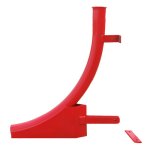boggen
Elite Member
- Joined
- Feb 22, 2011
- Messages
- 3,789
- Location
- Trivoli, IL
- Tractor
- SSTT (Sideways Snake Tain Tractor) and STB (sideways train box) tractor, dirt harvester
Yep, local codes rule. In Fairfax County, VA, in addition to the minimum depths, the electrical and water lines must have a minimum of 12" of separation of dirt, either vertical or lateral. They can be in the same trench so long as that separation is maintained. But running the water line directly below the electrical cable creates a huge headache later if you need to access it! If one trench is absolutely desired, the better practice is to use a 24" hoe bucket and lay the lines on either side. Or a narrower bucket and create a ledge for the electrical.
problem in same trench, is i like to "snake" both electrical and hose lines within the trench, so if there is some frost heave, "more so settling" the wire and/or hose. has some slack to move. vs stretching and breaking / cracking / splitting.
when i say "snake" more of a WWWWWWW back and forth through the trench. (if the W's were one constant line)
digging up old lines, i have found a noticeable difference between say someone taking a potato plow / middle buster, and just pulling wire/hose in one constant tight line/trench. vs weaving / snaking the wire/hose into a trench. the stuff that was put in as one straight line, has more nicks in it, and for wires the insulation was discolored in some places (stretching of the insulation happened) or you could take your fingers to the insulation and almost roll/rub it off. and like doings with plastic hose water lines and LPG copper line.

